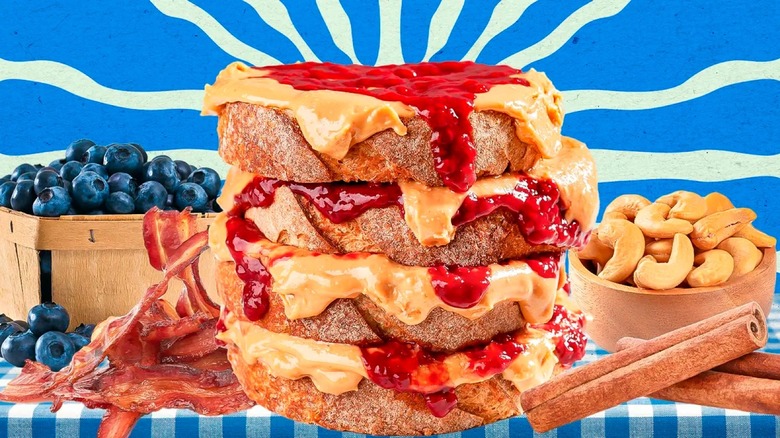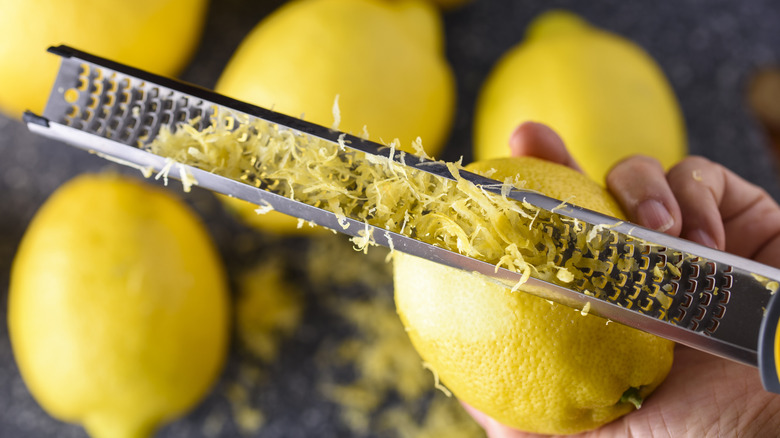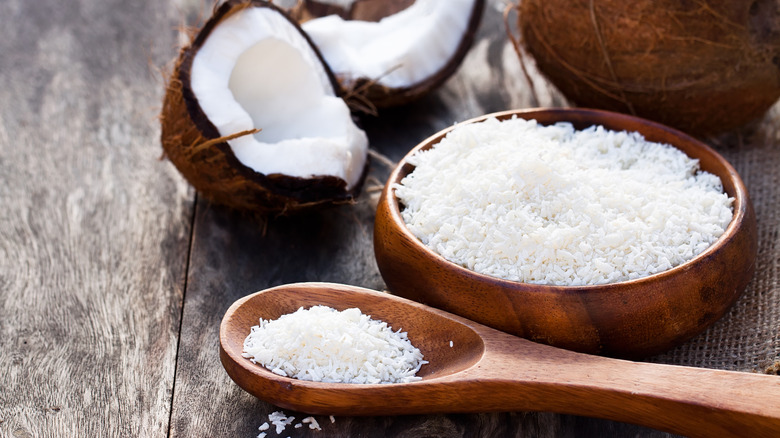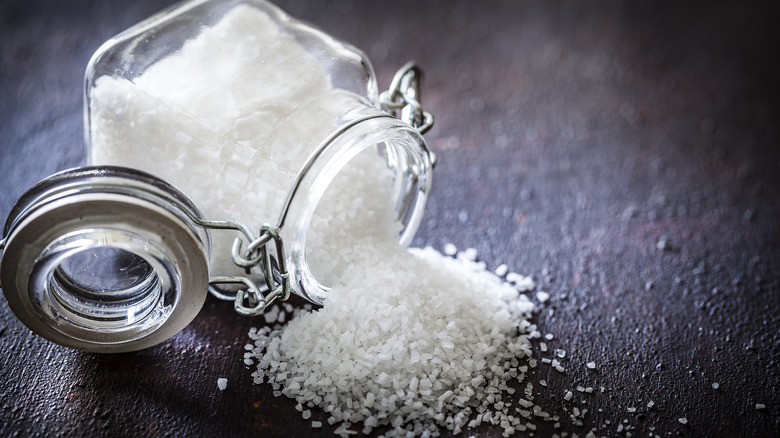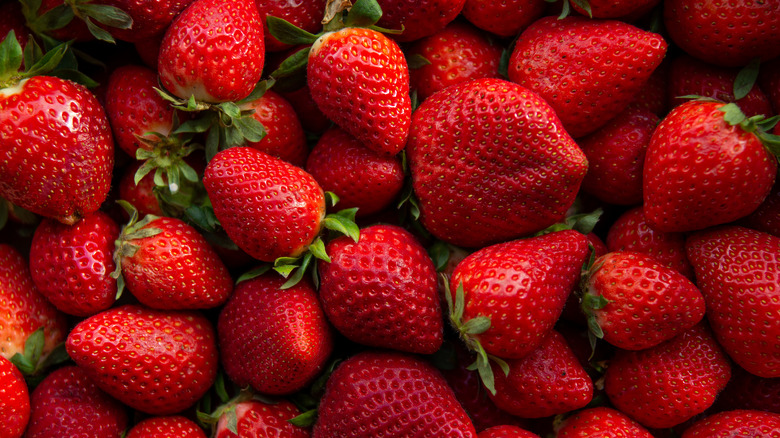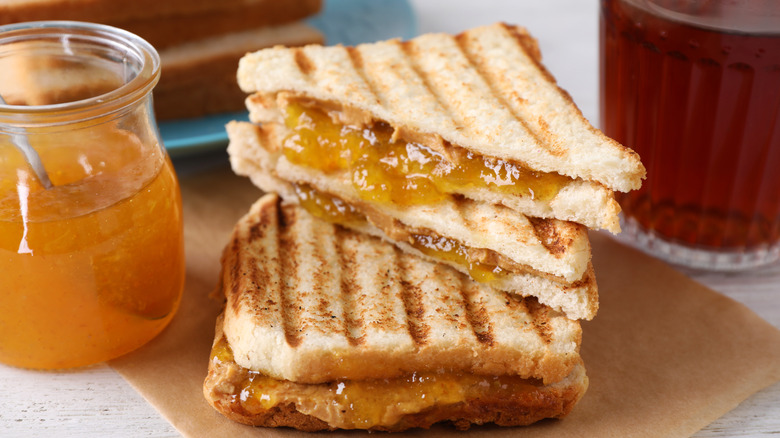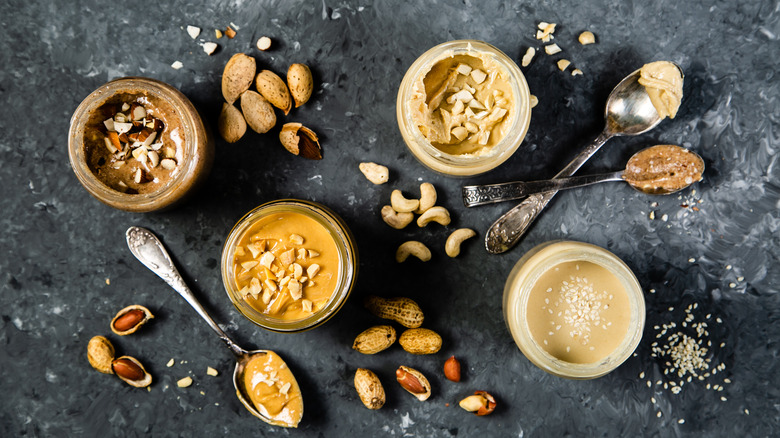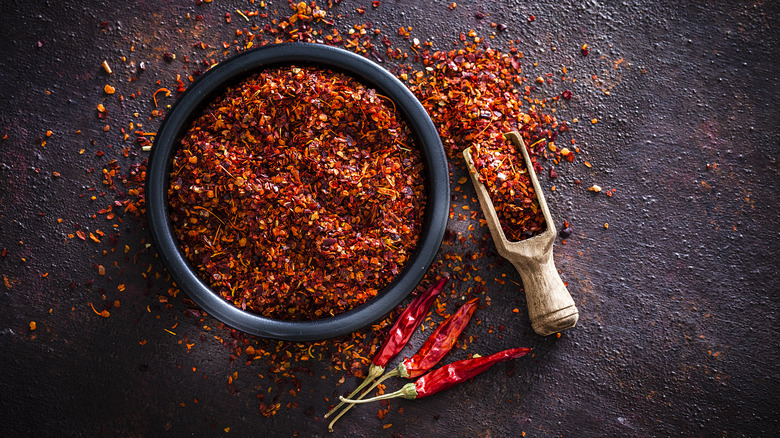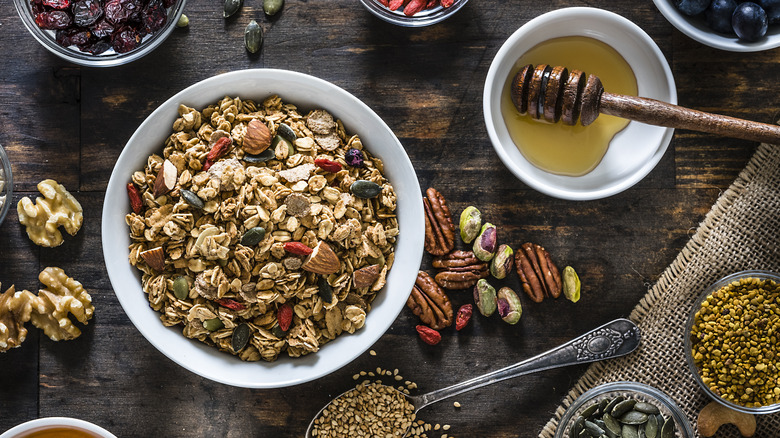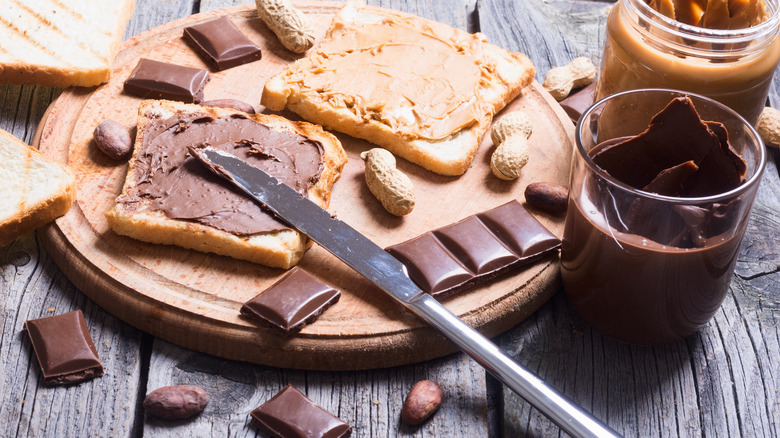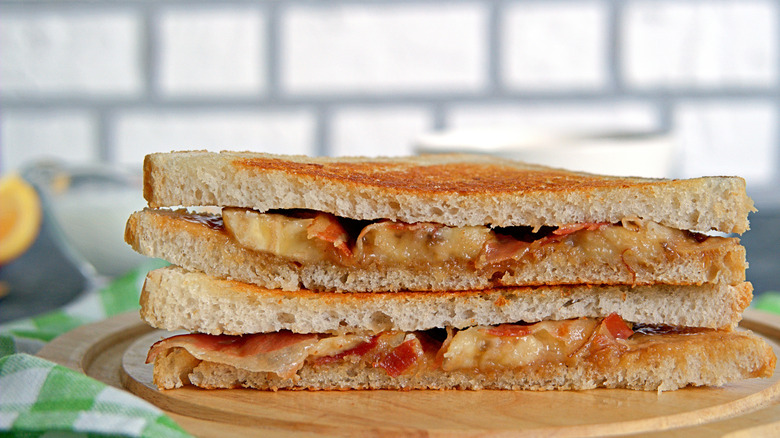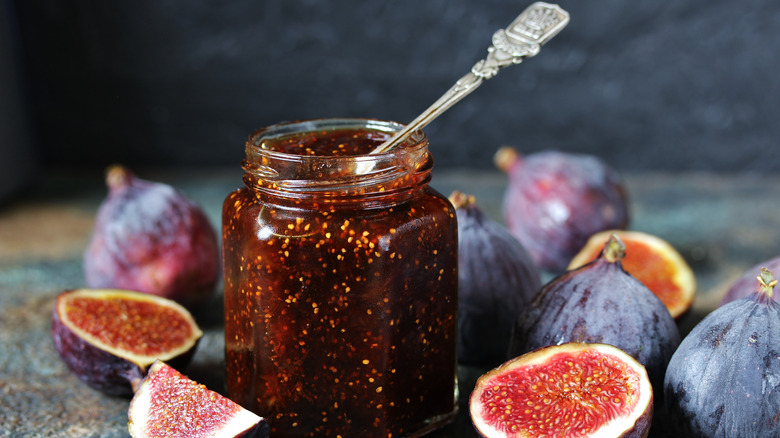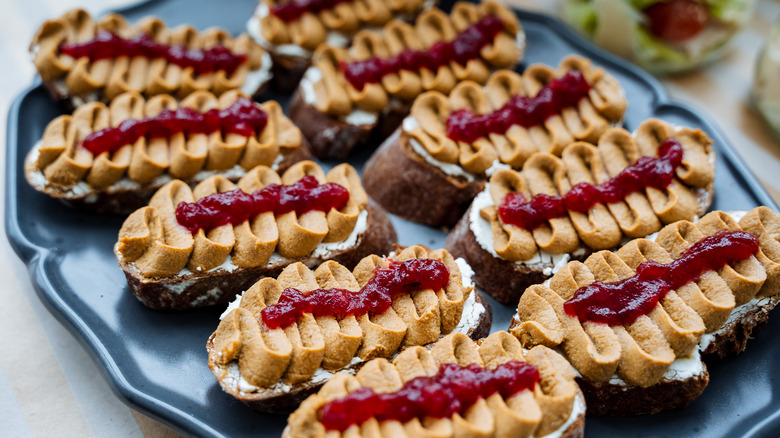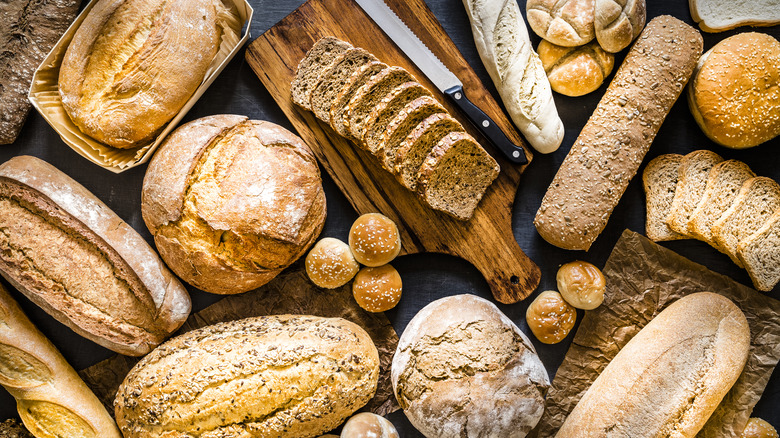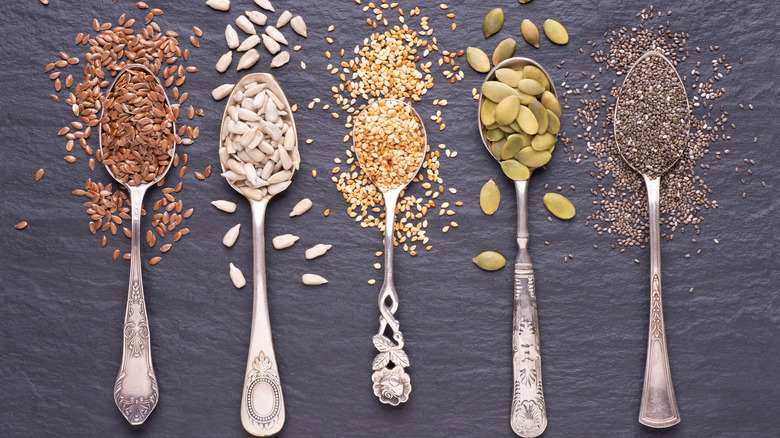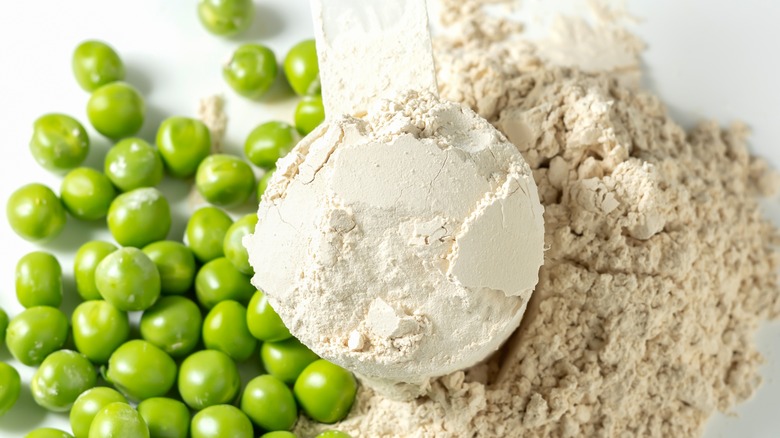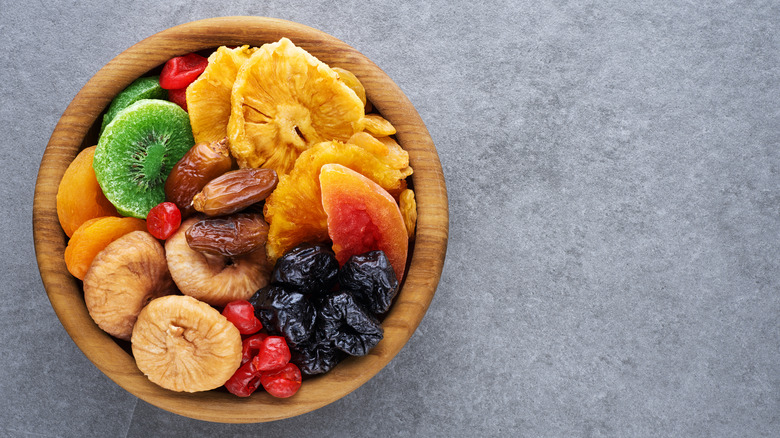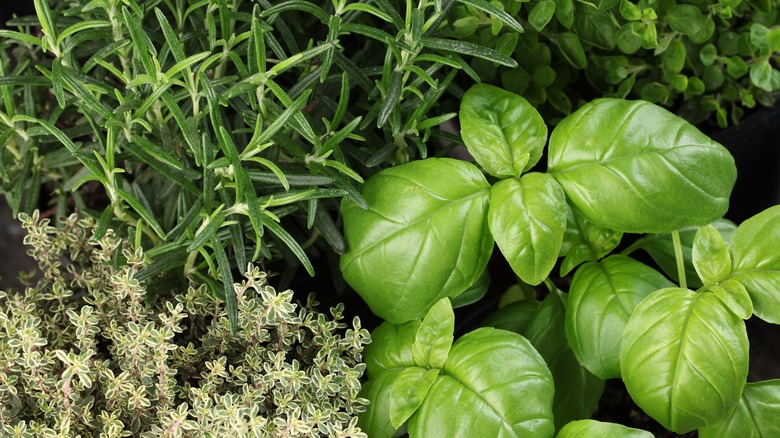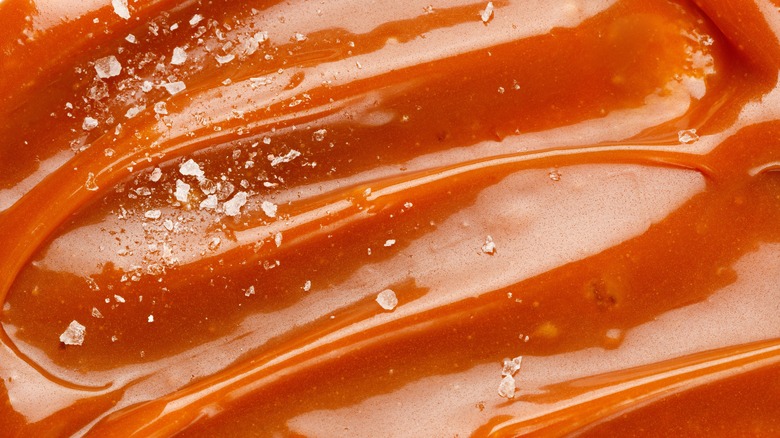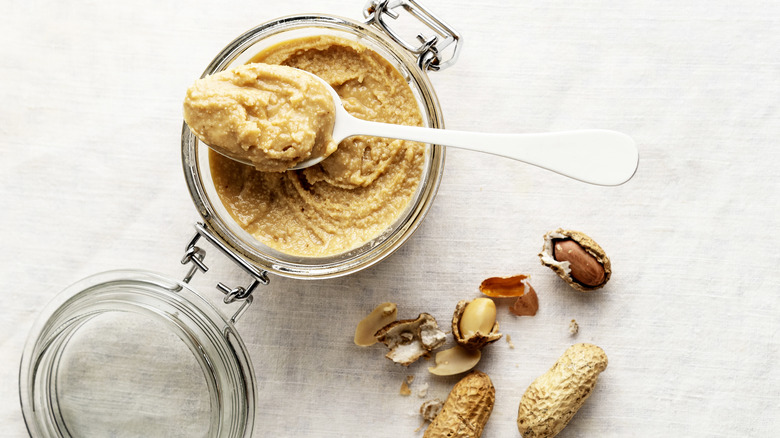20 Ways To Upgrade Your Peanut Butter And Jelly Sandwich
Peanut butter and jelly, the lunchtime staple of childhoods across the United States, doesn't need a dramatic makeover. After all, its simplicity and universality is what makes it so perfect. Unless you're allergic to peanuts, chances are good you've eaten your fair share of these sandwiches — and enjoyed them.
Shaking things up can help cast a new light on an old favorite. Peanut butter is experiencing a rebirth, with high-end peanut butter brands offering artisanal, quality ingredients to elevate your simple PB&J. The most basic spread requires only peanuts and salt, but these days, this lunchtime staple is gussied up with additions like coconut oil, natural sweeteners, and even chia seeds or other nuts.
Peanut butter is getting an upgrade, so shouldn't the entire sandwich experience follow suit? If you're ready to try something different, from the bread to the spread, here are 20 ways to upgrade your peanut butter and jelly sandwich.
Get zesty
For peanut butter that pops, pull out the zester and add citrus zest to your sammie. Citrus' bright, bitter sourness pairs perfectly with sweet and earthy peanuts, elevating both flavors; it is even better when paired with an unusually sweet jelly. The tart zest essentially counterbalances sugary jellies and jams and works to bring everything into harmony.
A note of caution: Do not add lemon juice to your peanut butter. This might be a common practice when making peanut sauce, but adding juice alone will cause your peanut butter to clump up and turn dry. In sauce making, this is counteracted by adding water or other liquids, but even jelly won't save the texture if you add straight citrus juice to your spread.
Go tropical
Coconut and peanut butter are natural compatriots when it comes to flavor profiles. Both are naturally sweet and nutty, with a taste at home in sweet and savory dishes alike. Therefore, it makes sense that this pair would add flavor and texture to wake up an everyday sandwich and make it something special.
Shredded or flaked coconut works well. Flaked coconut will be chunkier and provide more bite, and shredded is less intrusive in your eating experience. Shredded coconut is usually unsulfured, as is organic coconut. This means it has fewer preservatives than its flaked counterpart. If you choose sweetened coconut, use natural peanut butter with no added oil or sugar. This will balance the coconut and make the flavor less overwhelmingly sweet.
Be sweet and salty
Professional chefs understand the power of salt. Contrary to what many home cooks think, it's not the salty flavor chefs are after when they sprinkle on finishing flakes of fleur de sel — salt wakes up other ingredients and makes them taste more fully of themselves.
The same is true of a peanut butter and jelly sandwich. If you make no other change, consider sprinkling some finishing salt onto your sandwich before you tuck in. That said, only certain types of salt work for this application. Skip the iodized table salt for coarse sea salt or other flaked options. Not only does this provide a lovely sweet-salty contrast, but it also adds a bit of crunch. Are you looking for something different? Try smoked salt or rare red Hawaiian salt. Both add an unexpected flavor element to wake up a dull PB&J.
Add fresh berries or fruit
With so few elements, a peanut butter and jelly sandwich needs each part to be perfect, and jelly is sometimes where it falls flat. Many store-bought versions are mostly sugar and added flavor, with little berry flavor (or even berries, in some cases).
Skip the middleman and head straight to the fruit itself. Incorporate a layer of fresh mixed berries like raspberries, blueberries, and blackberries instead of jelly, or place them on top of the jelly for added freshness and texture. Another way to add fresh flavor and texture in one go is by adding paper-thin apple slices. Use a mandolin for uniformity, and go for many thin layers of apple instead of one thicker slice; this makes it easier to eat.
Play with prep
Convenience is a reason PB&J is the daily lunchbox choice, but when you have more time, mix up the prep. There is more than one way to put your sandwich together, often with surprising results. Try an air fryer PB&J for an even, toasty crunch in minutes. Buttering the outside gives it a lovely, velvety glow. Then, cook it open-faced (jelly on one side, peanut butter on the other) and combine after cooking.
With char marks and a subtle smoky flavor, grilled peanut butter and jelly is an indulgent way to put a new twist on an old favorite. You can also fry it in a skillet like a grilled cheese (with butter or mayo on the outside for a crispy crust) or use a panini press to get grill marks without leaving your kitchen.
Go nuts
Per Mount Sinai Health System, peanut allergies have risen, and food companies have responded by creating numerous other nut butters. Some people allergic to peanuts do not react to other nuts, meaning they can safely enjoy an alternative nut butter and jelly sandwich.
Mix different types of nut butter like almond, cashew, or hazelnut with traditional peanut butter (or use them on their own). Keep in mind that each will have a slightly different flavor profile. This is another opportunity to experiment with other jellies, jams, and toppings you might have shied away from using with peanut butter.
Read labels carefully, as some nut butter is manufactured on shared equipment. This means they might still have traces of peanuts, which can be harmful. If your allergies are life-threatening, a quick skim of the label could save your life.
Make it spicy
Peanuts are flavorful enough solo, but let's not overestimate their intensity. They don't have an explosive taste that wakes you up. However, you can change that by adding a spicy kick. Add a sprinkle of cinnamon to put your sandwich on the milder side of wild, or get really spicy with some red chili flakes, a dash of cayenne, or chipotle powder. Chipotle has a smoky undertone that adds a new depth to earthy peanuts.
If using chipotle powder, consider adding a few mini chocolate chips. Spicy, smoky, earthy, bitter, and sweet, this combo will bring an unexpected twist to an everyday sandwich. It's not for everyone, but if you enjoy spice, then it might be for you.
Give it some texture
Soft bread, soft jelly, creamy peanut butter: There is such a thing as too many monotonous textures. Punch up your tastebuds — and give your teeth a workout — by adding some texture. Make your sandwich as usual, then top it with chopped nuts or granola. Make homemade granola to customize your upgrade even more.
Another way to give your sandwich some texture is by adding potato chips or crushed pretzels. This adds salt to bump up the sweetness of a classic peanut butter and jelly. If you want to go on a taste and texture journey, add crushed chocolate-covered pretzels to a peanut butter and strawberry jelly sandwich. Pick peanut butter with no added sugar to balance the chocolate pretzels. Alternatively, you could opt for crunchy peanut butter.
Make it dessert
Peanut butter and jelly is as at home after dinner as it is for dinner. You can make an elegant dessert from humble ingredients with some minor adjustments. To start, you need soft bread pressed into thin pieces. Add a thin layer of chocolate spread or Nutella with your peanut butter, then a slice of bread and another layer of chocolate and peanut butter.
Alternatively, skip the second layer and add pistachio butter instead of peanut butter. If you swap pistachio butter, make sure it's not pistachio cream, a sweet Italian confectionary spread. Once you've added your dessert spreads, cut the crusts off the bread and either cut them into small triangles or use cookie cutters for a more decorative flair.
Get savory
Let's face it: Peanut butter has always walked the line between sweet and savory. It's a feature in peanut stews and spicy sauces, so it makes sense to add bacon to your PB&J like Scott Gallegos, chef de cuisine at Muse at the Corcoran, does. He also grills his favorite after-work sandwich, taking an extra step to achieve the best flavor.
You could also go full Elvis and add banana slices to your peanut butter and bacon sandwich. Make sure your bacon is cooked how you like it, then assemble the sandwich by spreading both sides of the bread with peanut butter before adding banana and bacon. Fry it like a grilled cheese, press it in a panini, or go with an air fryer for a quick after-hours snack.
Ditch the grape
You're a grown-up, so it might be time to put away childish things. Unless you're still prepping PB&J for kids, there's no reason to stick with grape jelly. Grape jelly is a bona fide classic and shouldn't be discarded permanently, but you can experiment with new jams and jellies. If you like a particular jam on toast, there's no reason it won't work with peanut butter, too.
Different types of jellies and jams go well with peanut butter — think fig and spicy pepper jelly. Both also pair well with cheese, which kicks everything up a notch (see below). Other grown-up options include more complex jams, like rosemary and pear jam. It brings an herbaceous note to the sandwich (along with a more sophisticated flavor profile) and is simple to make at home.
Deepen the flavor with... cheese?
Cheese is one of the best ways to elevate a peanut butter and jelly sandwich. It adds a creamy texture and luxurious depth of flavor to make the sandwich more than the sum of its parts. Think of it this way: Cheese and nuts are often paired on charcuterie boards, and peanut butter is just nuts in a different form.
Of course, not all cheese works. Think of textures and mild flavors like Brie, cream cheese, and mascarpone. Gouda is a more robust flavor that adds a hint of smoke to your sandwich. Stay away from funky cheeses that would overwhelm the peanut butter. Slice the cheese thinly or use a thin layer to start; balance is crucial. For best results, consider a type of jelly or jam to pair with your cheese of choice instead of focusing on how it matches your peanut butter.
Bust out the special bread
The best time to eat special bread is today. What is special bread? That artisan sourdough you've been craving. The crusty baguette calling out your name at the corner bakery. The handmade bagels from the deli down the street. Don't save these little treasures for a rainy day when they're stale and past their prime. Immediately upgrade your peanut butter and jelly by spreading it on a high-quality bread product.
Special bread can also include any baked good you can split open and fill. Think homemade fluffy biscuits, scones, and flatbread. Brioche is a slightly sweet, enriched bread that makes a great toasted sandwich, and dinner rolls work well if adding fruit or other ingredients. You might even try peanut butter and jelly on rosemary focaccia or other savory breads.
Whip your peanut butter
Peanut butter is arguably delicious as-is, but for another textural change, add some air. Whipping your peanut butter makes for a creamy, fluffy filling that's delightful and feels like a celebration.
Add more protein to your whip by incorporating low-fat Greek yogurt. This adds tang and richness — and makes it feel more like dessert. If you find Greek yogurt too tangy for your liking (or want to use nonfat Greek yogurt, which can taste a little off), elevate your PB&J with some honey to balance the tartness. There's no formula here: Start with 1 tablespoon of peanut butter (half the typical serving size), and add Greek yogurt and honey to taste. Use a wire whisk or hand mixer and beat until fluffy.
Just add seeds
A sandwich isn't complete without a crunch, but before you reach for potato chips, consider adding that crunch inside the sandwich itself. Seeds add crunch and pack a lot of nutrition in your lunch.
Flaxseed and chia seeds are good to start with. Flax is high in fiber but works best in that regard when ground. You'll still get benefits even if you leave them whole, and if you toast the seeds, they provide another nutty flavor. Chia provides a bump in protein and is packed with healthy omega-3 fatty acids. Make sure to sprinkle them on last, though, as they absorb liquid and take on a texture that not everybody loves. Other seeds to try include sesame, pumpkin, and hemp seeds.
Pack it with protein
Even though peanut butter has protein, its fat content sometimes negates the nutritional benefits. If you love PB&J as an on-the-go option, stir some protein powder into peanut butter for an energy-packed sandwich.
Protein powder comes in various forms, some flavored and some plain. Plain protein powder has a neutral flavor that some may find unpleasant. Whey protein is one of the mildest options on the market but contains lactose. Pea protein has one of the most distinctive flavors but is a fantastic source of vegan protein.
If you avoid animal products but dislike plain protein powder's taste, considering a flavored option might be worth your while. Most protein powders come in chocolate and vanilla, but fruit flavors are also available. If you opt for flavored protein powder, use natural peanut butter to avoid too much sweetness.
Punch it up with dried fruit
Texture, texture, texture. Texture influences how we feel about what we eat — sometimes, too much soft food isn't satisfying. Add texture to your PB&J with dried or freeze-dried fruit. Dried fruit is an excellent choice for people who like a slight chewiness in their food. The low moisture levels provide a chewy texture, and what's left is the strongest essence and flavors of the fruit. Think dried apricots, figs, and raisins.
Another way to add texture is with freeze-dried fruit, the crunchiest of the preserved fruit options. Freeze-dried fruits have the same intense flavor but with no moisture. Try layering your sandwich with the same jam and freeze-dried fruit. For example, pairing strawberry jam with freeze-dried strawberries. One plays off the other for a beautiful and complementary depth of flavor.
Consider adding herbs
The quality that makes peanut butter and jelly so practical — its durability and staying power — is the same thing that can make it a little dull. Few dishes can resist the Siren call of fresh herbs, and PB&J is no exception.
Fresh herbs bring a vibrant brightness to everything they touch. When it comes to peanut butter and jelly, they play along the edge of sweet and savory in a way that upgrades the entire sandwich. When choosing herbs, consider the jelly more than the peanut butter, which is a base layer. Add a chiffonade of basil to strawberry jelly, finely chopped thyme to blackberry jam, and rosemary to pear or apple jelly. Your herbs should be fresh — dried herbs will not work in this application.
Substitute caramel for jelly
Caramel is the sweet, sultry sauce that can make a boring peanut butter sandwich come alive. Skip the jelly and add a drizzle of rich caramel for a sandwich that's anything but basic. Make an open-faced peanut butter sandwich in your air fryer to intensify the flavor — and make it more of a special occasion. Use sourdough bread, buttered outside, and a generous smear of natural nut butter (any flavor, crunchy or creamy). Once your bread is golden and toasty, add a brushstroke of caramel to one side and close the sandwich.
Upgrade it by making a homemade salted caramel sauce or sprinkling your sandwich with fleur de sel before serving. Use peanut butter with no added sugar, and skip the jelly. However, you can double up and add fresh fruit if you like.
Make your own peanut butter
Making homemade peanut butter is the ultimate upgrade, with a freshness and flavor you can't get with even the best store-bought brands. It doesn't take long, but you won't believe the difference.
One key step? Roast your peanuts before you process them. This brings the oils to the surface and deepens the flavor. Roast in a sheet pan at 350 degrees Fahrenheit for 10 to 15 minutes, shaking the tray so they don't burn. Remove loose skins and allow peanuts to cool before pulsing in a food processor with a bit of salt. You can add a little oil if you want a smoother texture, but this is not a requirement.
You can make nut butter from any nut following this simple formula — but don't skip the initial roasting for the best flavor. Make enough to last a week in the fridge. While it can technically last for a month or more, oils can turn rancid quickly, imparting an off taste. If this happens, throw it out.
